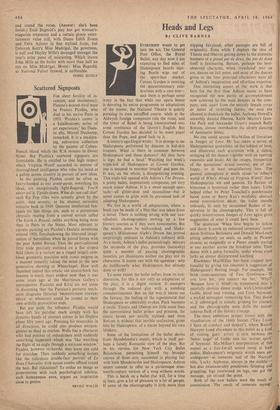Scattered Signposts
FOR sheer fertility of in- vention, and inconstancy, Picasso's nearest rival must be Francis Picabia, who died in his native Paris in 1953. 'Picabia's career is a kaleidoscopic series of
art experiences,' his Dada- , ist ally, Marcel Duchamp, remarked. It is a madden- ing, subversive collection by the painter of Cuban- French blood which the ICA mounts in Dover Street. But Picabia's scattered signposts are formidable. He is entitled to that high respect which Virginia Woolf accorded to anyone of thoroughbred intelligence who rides his mind at a gallop across country in pursuit of new ideas.
In his painting Picabia could be often as heavy-handed as our avant-garde, reworking his ideas, are exceptionally. light-fingered. You'll never sell it, Upside-down, What do you call that? such flip Pop titles were actually given by the artist, then seventy, to his abstract surrealist conceits' back in 1949. Queerest intellectual fan- tasies his late things are, such as a portentous chrysalis rearing from a curved terrain called The Earth is Round, unlike anything being done then in Paris or the States. Most relevant to current painting are Picabia's Dadaist inventions around 1920, foreshadowing the liberated imagi- nation of Surrealism when he joined forces with the poet Andre Breton. Thus the parti-coloured little nude precisely outlined on a flat striped field (there is a variant on a ringed target) com- bines geometric precision with ironic enigma in a manner instantly taking the mind to the new generation showing at Whitechapel. How well thumbed indeed this erratic old source-book has become is much more evident now than it was some years ago at the Matthiesen Gallery's retrospective. Paolozzi and Kitaj are not alone in discerning that the Parisian's perverse mech- anist diagrams (lettered `PROSTITUTION UNIVER- SELLE' or whatever) could be turned to their own artfully provocative ends.
But put aside the influence. Picabia would have left his peculiar mark simply with his dynamic bands of abstract colour in his Orphist phase fifty years ago. Pursuing his researches in all directions, he could also produce extrava- ganzas as dead as mutton. Wells has a character who had patches of ordinariness until suddenly something happened which was 'like watching the flight of an eagle through a staircase window.' Picabia, however recherché, may leave one cold for stretches. Then suddenly something occurs like the ridiculous double-face portrait of Le Beau Charcutier with actual combs affixed round the hair. But ridiculous? To endue an image so preposterous with such psychological subtlety, such humaneness even, argues an inspiration close to genius.
NEVILE WALLIS






































 Previous page
Previous page